You are using an out of date browser. It may not display this or other websites correctly.
You should upgrade or use an alternative browser.
You should upgrade or use an alternative browser.
Side Hustle - Social Media 101 - social media image size - RESOURCE
- Thread starter mailboxpimp
- Start date
Quick References
All dimensions below are in pixels, width x height.
Facebook
All dimensions below are in pixels, width x height.
- Cover image: 828 x 315
- Profile image: ≥180 x 180
- Shared image: 1200 x 900
- Shared link preview image: 1200 x 628
- Header image: 1500 x 500
- Profile image: 400 x 400
- Timeline image: 506 x 253
- Profile image: 250 x 250
- Cover image: 1080 x 608
- Shared image: 506 pixels wide
- Shared video: ≥506 x 284
- Shared link image thumbnail: 150 x 150
- Profile image: 110 x 110
- Image thumbnail: 161 x 161
- Shared images: 1080 x 1080
- Shared videos: 1080 pixels wide
- Profile image: 180 x 180
- Board cover image: 214 x 100
- Pin preview: 238 pixels wide
- Banner image: 1850 x 200
- Profile image: 400 x 400
- Cover image: 1536 x 768
- Shared image: 350 pixels wide
- Shared link preview: 180 x 110
- Logo image: 400 x 400
- Channel cover images: Varies by viewing platform
- Channel icon: 800 x 800
- Video thumbnail: 1280 x 720
- Profile image: 128 x 128
- Image post: 500 x 750 | 1280 x 1920 maximum
- Geofilter: 1080 x 1920
THE NETWORKS
For easy access to the information you’re looking for, click on one of the following to jump to that section:
FACEBOOK
Featuring high-quality imagery on Facebook shows your audience that your business is legitimate, reputable, and pays attention to the details (no matter how small).
Facebook wants to provide a positive user experience and prevent advertisers from being overly promotional or spammy, so they check to see how much text is featured in each image. Use this tool to see if your images adhere to Facebook’s text-to-image ratio.
PROFILE AND COVER PHOTOS
Most businesses use this space for their logo rather than a person’s photo. However, if your business is run by you and only you, using a photo of yourself might not be a bad idea.
SHARED IMAGE (TIMELINE & NEWS FEED)
These images appear both on your timeline and in most of your followers’ news feeds. With the decline of Facebook’s organic reach, try asking your fans to like or share your photos to gain visibility without a significant financial investment. Or consider paying a small fee to boost posts to ensure that your audience sees it in their feed.
SHARED LINK PHOTO
If you’re sharing a link to your business’ Facebook Page, there are a few more elements to consider and formats to choose from. When you paste a link into your status, depending on the size of the images on the web page, you’ll be prompted to include a carousel of up to 10 images. You also have the option of sharing the link without using the image — which can come in handy if you’d rather upload a new image to share with the link instead.
Pro Tip: Sharing images and links from other sources allows you to post relevant content to your page when you don’t have time to create your own. It’s also a great way to share content contributed by your audience or other businesses and keep promotions to a minimum.

TWITTER
Known for its real-time social buzz, Twitter is also an extremely popular customer service and experience tool for businesses.
PROFILE AND COVER PHOTO
Your profile photo will be visible on your profile, in your news feed, and next to a link in the “Who to follow” box. Most businesses use this as a place for their logo because it is seen practically everywhere: when you tweet, when others retweet your tweet, when their retweet gets retweeted, and so on.
Your cover photo, however, is only seen when a user clicks to your profile – but that doesn’t mean it’s not important! It’s a large photo across the top of your profile, so you want it to be high quality and represent your brand.
Note: Twitter recommends that you upload your cover photo dimensions at 1500 x 500 pixels, but because the cover photos are responsive, yours may look larger or smaller depending on the size of your browser or screen.
Pro Tip: Cover photos are a great place to describe what your brand does, display a new product, or use as free advertising space.
IN-FEED PHOTO
Twitter may have a limit of 140 characters, but you can use visuals to assist in representing your brand and sharing your content.
Attaching a photo to your tweet used to take away 23 characters (because it needed the URL to link to the photo), but in 2016, Twitter announcedthat links and media attachments (e.g. photos, GIFs, videos, and polls) will no longer count as part of the 140-character limit. This is great for marketers because tweets with images are over a third more likely to be retweeted than those with only text.

TWEETDECK
You can’t make separate images for Twitter and TweetDeck since TweetDeck is not a separate social network, so everything you post on one site will show up on the other (there’s no way around it).
However, you still want to take into consideration the way that your Twitter images appear on TweetDeck because the dimensions do vary in size a bit.
Pro Tip: Some of your header image design will be covered by your profile photo and bio in TweetDeck. So if you have important text or imagery that you’d prefer be seen at all times, be careful about centering those elements.
An example of a cover photo optimized for TweetDeck:
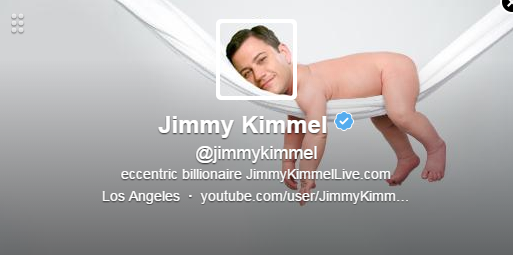
The same cover photo on the desktop version of Twitter:

 GOOGLE+
GOOGLE+
Google+ underwent a substantial redesign in the last year, giving many marketers and everyday users hope for the social network’s future. When a user performs a Google search for your business, elements of your Google+ profile, such as your location and reviews, will likely be listed, as well as links to recent posts on Google+ (when applicable). So while Google+ may not be the top social media platform, it certainly shouldn’t be ignored.
PROFILE AND COVER PHOTO
Keeping in mind that your Google+ profile may show up in search results, you’ll want to ensure that your profile image is high quality and that you have recent posts available for viewing. Also note that even though you upload your profile photo as a square, it will display on your page as a circle.
Regarding your Google+ cover photo (as with most cover photos), it’s the largest image at the top of your profile, so you’ll want clear and creative visuals to portray your brand.
SHARED IMAGE
When sharing on Google+, you have the option to share publicly, within a Collection, in a Community, with a Circle, or with an individual. Collections are much like Pinterest boards where you can organize and collect images or links about a particular topic. It helps keep your content organized and allows other accounts to pick and choose which Collections they want to follow based on their areas of interest.
A Community is a place where people can discuss and share news on common topics of interest. Circles are your account’s followers grouped together based on certain criteria (e.g. friends, colleagues, etc.).
SHARED LINK
When you paste a link to share on Google+, it will pull a photo from the web page and add it to your link as a small square or rectangle, depending on the original image size. If the web page has multiple images on it, you can flip between them to choose the image you’d like to feature in your post.
Pro Tip: Sharing relevant content in Google+ Communities is a great way to raise brand awareness, promote your page, connect with other users, receive quality post engagement, and potentially get traffic to your blog/website.
But don’t overdo it: when you post to a Google+ Community it also shows up on your profile, so sharing the same post to several Communities tends to look spammy.

Note: Here is the old/”classic” Google+ profile layout, which you will see if you haven’t switched over to the new Google+ yet. Even if you have the new layout, you can switch back to the “Classic Layout” at your leisure.
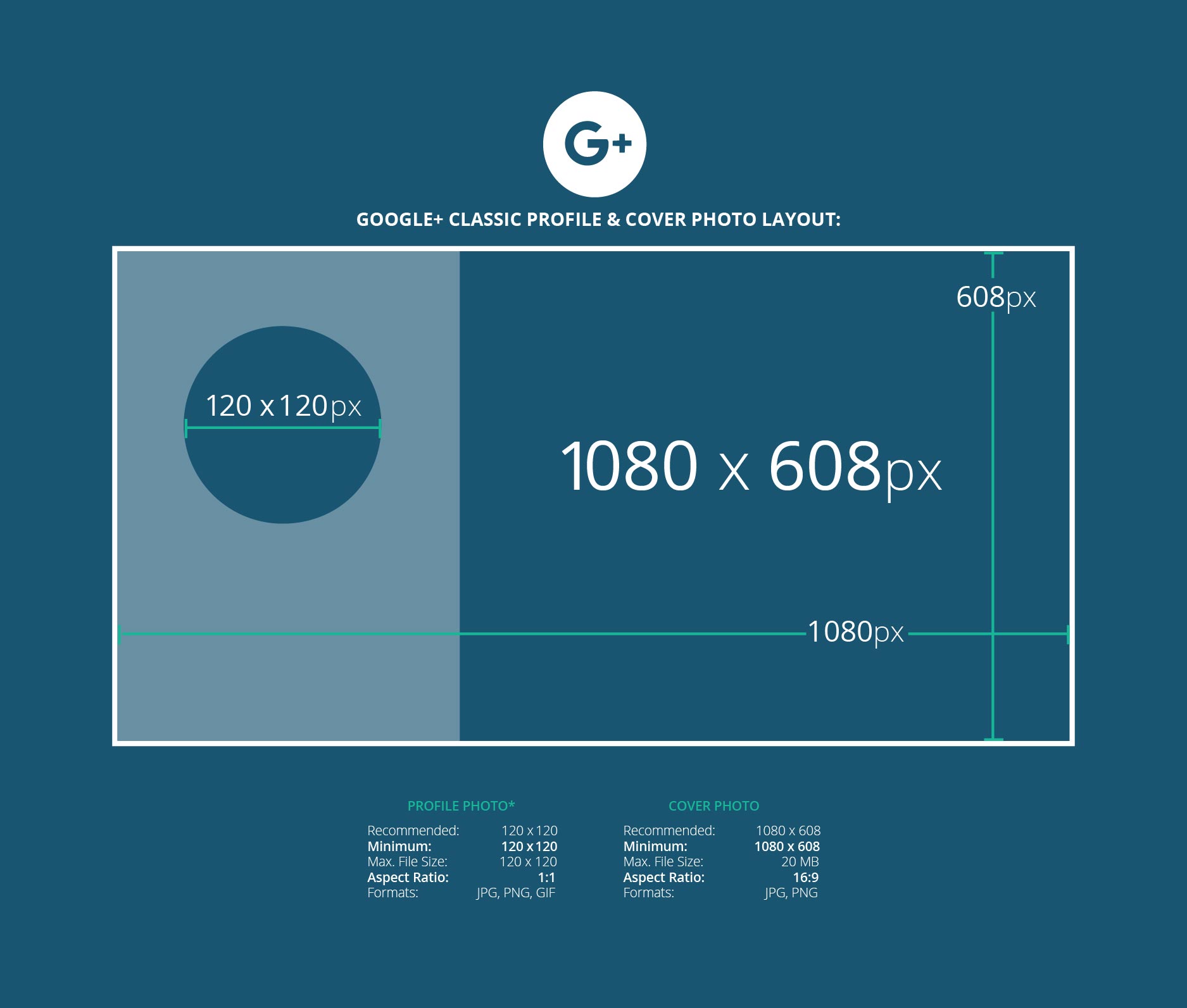
PINTEREST
Pinterest is also a great search tool, with 69% of users having purchased or considered purchasing something they found through a search on the network.
PROFILE PHOTO
This is one of the few platforms that doesn’t have a cover photo, so the representation of your brand rests heavily on the shoulders of your profile photo. Similar to Google+, Pinterest’s profile photo is uploaded as a square, but displays as a circle at the top of your profile.
PIN SIZE
With Pinterest’s layout being more portrait-oriented, vertically designed pins tend to perform better. When deciding on size, create a pin that caters to what you want to visually represent; larger pins do not necessarily mean you’ll attract more attention.
BOARD DISPLAY
The first thing you see when you visit someone’s Pinterest profile is their collection of boards. Name your boards appropriately and include a relevant cover photo for each of them. You don’t want empty boards (or no boards), but you don’t want a plethora of boards with no purpose, either.
Note: Some users began noticing a new Pinterest profile layout in July 2016 (see below). The new design has a larger profile photo next to the username and bio, along with a 3-photo grid for board cover photos.
Pro Tip: Ensure that your first two or three boards are directly related to your industry or audience. You don’t want visitors to leave your profile because they don’t understand what your business does or can’t quickly find the information they’re searching for.
Also, infographics tend to do really well on Pinterest.


LINKEDIN
LinkedIn is primarily for networking with other professionals, but it’s also a resource for businesses to connect with other businesses, prospective employees, and industry leaders. You can choose between a personal profile and business page (both with free or paid options).
PERSONAL PROFILE AND BACKGROUND PHOTO
You should have a respectable, professional photo of yourself for your personal LinkedIn profile.
On LinkedIn, the background photo replaces the “cover photo” at the top of your profile page. As an oblong shape, it can be difficult to find imagery that fits the space well – that’s where creating your own visuals comes in handy.
BUSINESS LOGO
The standard logo for a business account is a small square at the top of the profile page that is displayed next to your company’s name.
The square logo is what people see when they search for your company or see your posts in their news feed.
BUSINESS COVER AND BANNER PHOTO
Instead of a background, you can have a cover photo on a business page that stretches across your profile underneath your logo and company name.
Pro Tip: Use a photo of your employees or your business’ building as a banner photo – and avoid random stock photos. For background photos, it’s usually best to choose something subtle that doesn’t distract too much from the content of your profile.
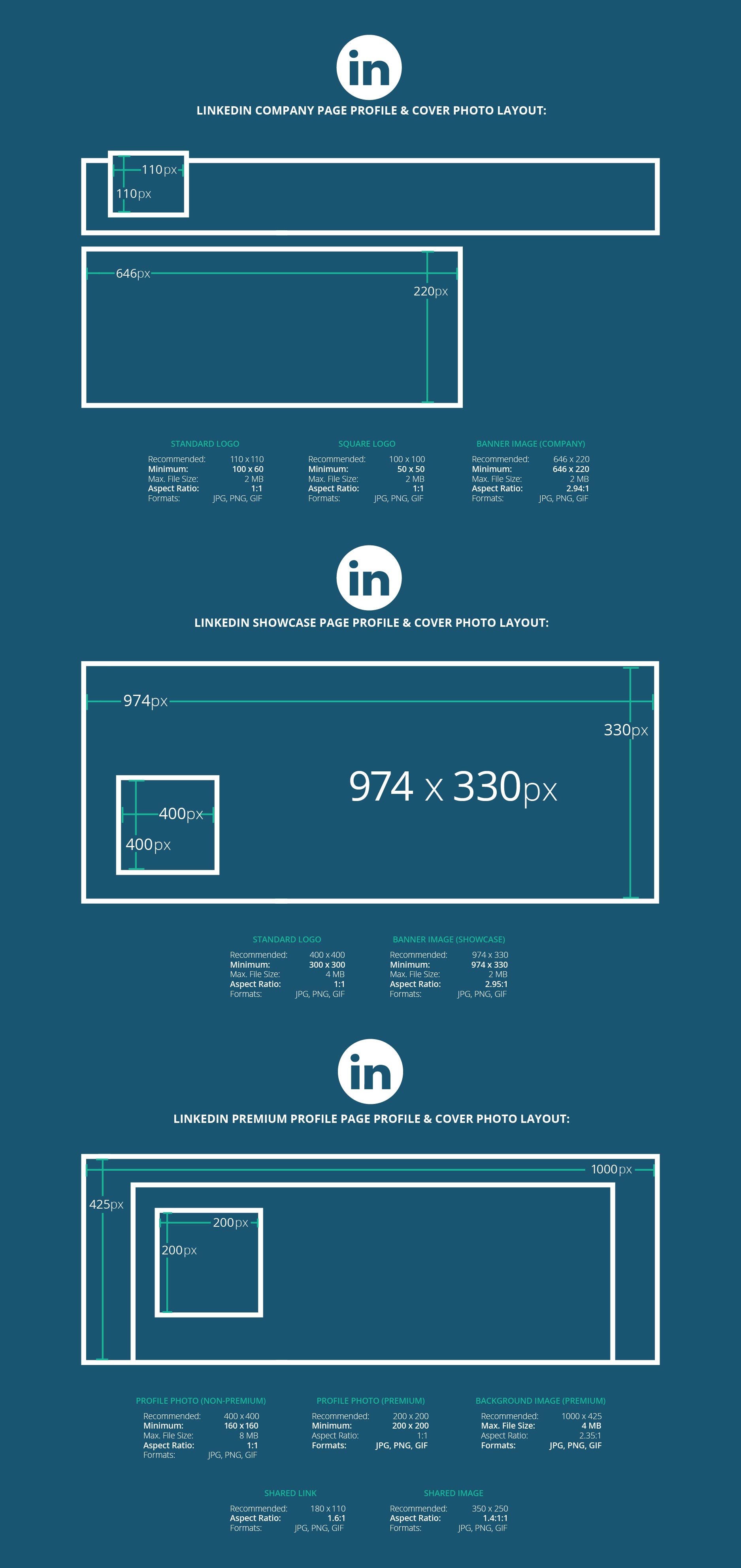
INSTAGRAM
Instagram is all about visuals, which should make the importance of high-quality images blatantly obvious for this social network.
PROFILE PHOTO
As with some other platforms, the profile photo is a circle that shows up next to all of your posts and at the top left of your profile page. For businesses, it’s a great idea to use your logo here so all of your photos are associated with your brand.
As of June 9, 2015, Instagram updated its profiles, feeds, and hashtag pages with a flat, minimal design – so there is no longer a cover photo.
Instagram also introduced the ability to upload portrait and landscape-oriented photos and videos in August 2015. And, to ensure images look sharp across all devices with high-resolution displays, Instagram rolled out support for images at a higher resolution (up to a 1080-pixel width) in July of 2015.
Pro Tip: This is a great place to show your company culture, what happens “behind the scenes” of your business, the process of creating your products, customers using your products, etc.

TUMBLR
Tumblr is a blogging and social platform where users share thoughts, quotes, music, articles, GIFs, videos, images – basically anything. Images are (of course) an important aspect of this social network, but text-based content is associated with Tumblr as well.
AVATAR (PROFILE PHOTO)
This photo will show up as a small square next to your posts in your followers’ main feeds and is embedded with your username in posts that users come across while perusing Tumblr.
You can choose a theme for your Tumblr page, which allows for added customization (think of it as a website or blog page); however, many users will still be able to see a “profile” preview with an avatar and header photo of your choice (see the GIF below for an example of the profile preview).
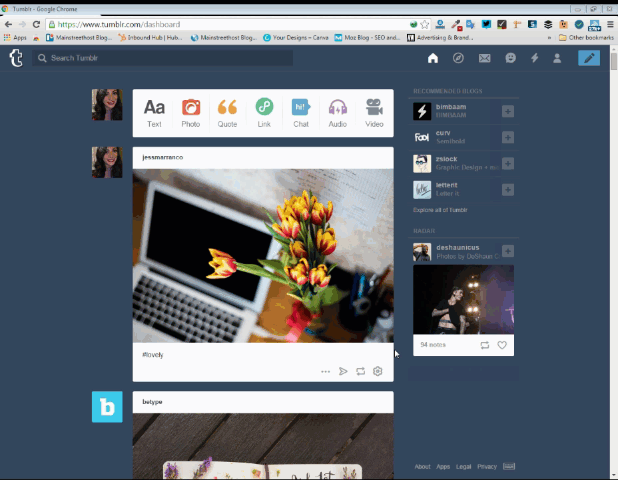
With that in mind, it’s important to remember that this header image will not show up on your Tumblr page unless you add it to your theme. Your avatar may also not be featured on your theme, but will show up as your Tumblr’s favicon on browser tabs.
Pro Tip: Consider placing your business’ logo directly on the photos you upload to increase brand visibility and recognition.
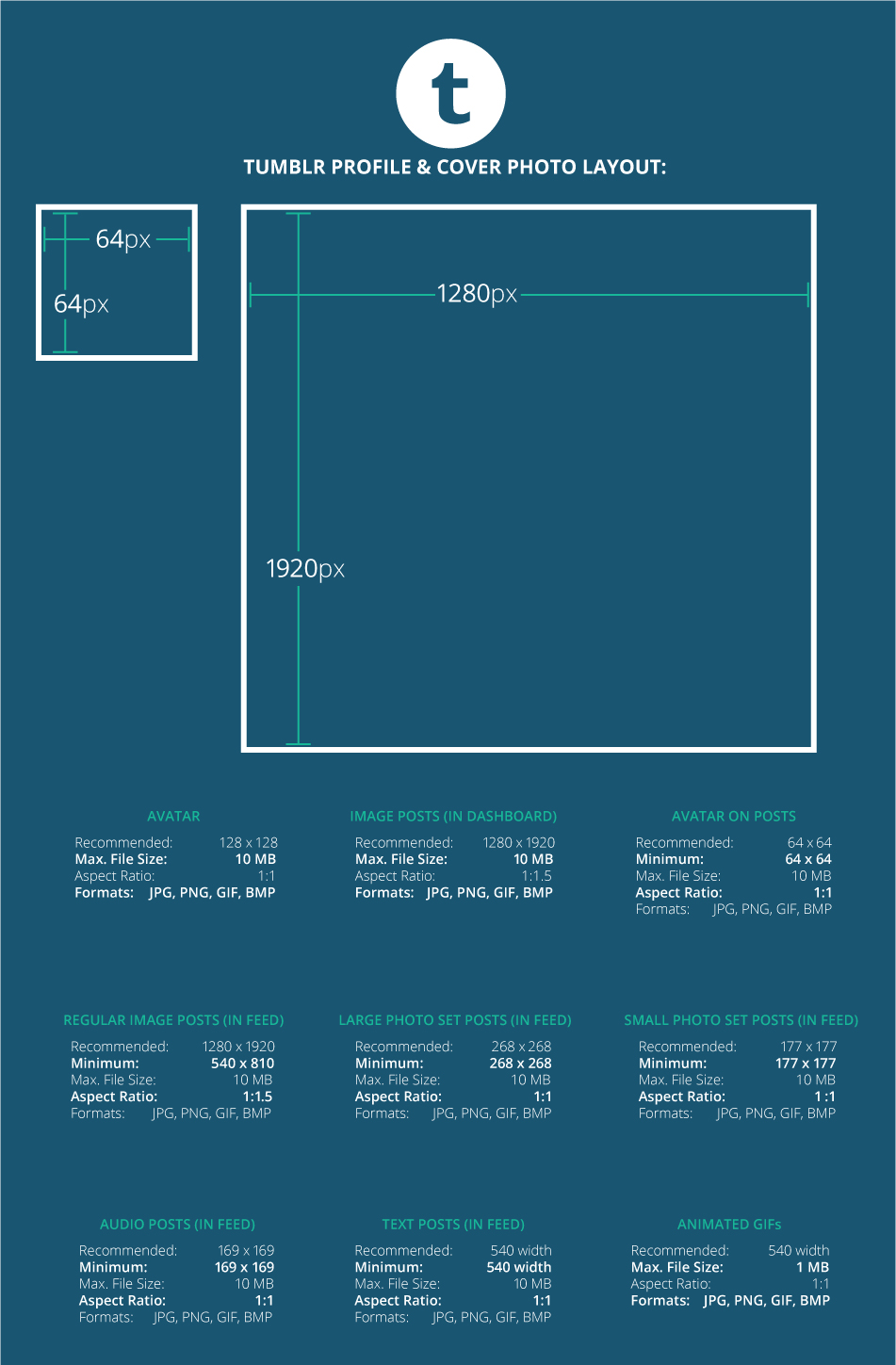
YOUTUBE
YouTube is a video-sharing social network that is accessed by users on the largest variety of devices, including tablets, phones, desktops, and televisions, so it’s important to have imagery that displays correctly across devices.
CHANNEL ICON AND CHANNEL ART
A small square profile photo overlays the top left corner of your YouTube page. As important as profile and cover photos are to representing your brand, on YouTube, many users will see one of your videos before them. This makes having striking images even more important so that users associate the videos with your brand and remember you when they do reach your profile page.
Note: Your YouTube account is connected to your Google+ account, so your channel icon will show up as whatever image you have as your Google+ profile photo. However, you can still upload a different image for the channel art.
Pro Tip: You only upload one image for your YouTube channel art, but it will display differently across different devices. When you upload an image, you can crop it to fit the desktop layout (see the GIF below for a demonstration) – but make sure the important elements are right in the center to ensure they aren’t cropped out on smaller screens.
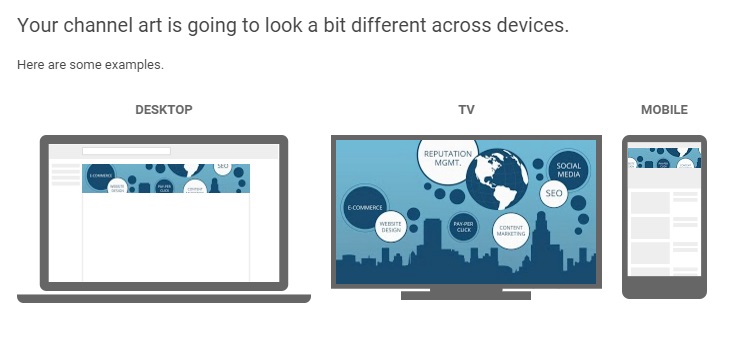
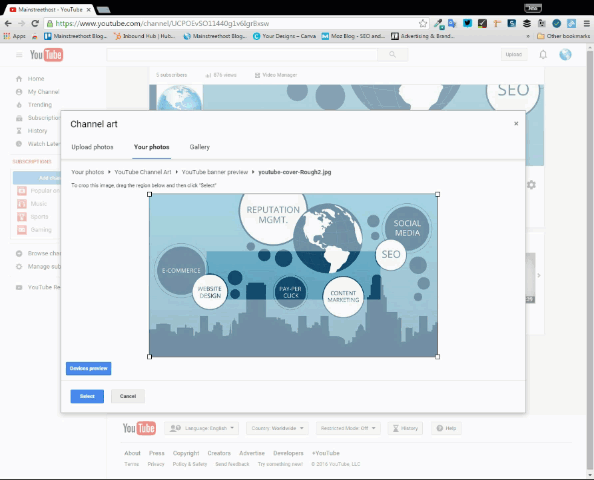
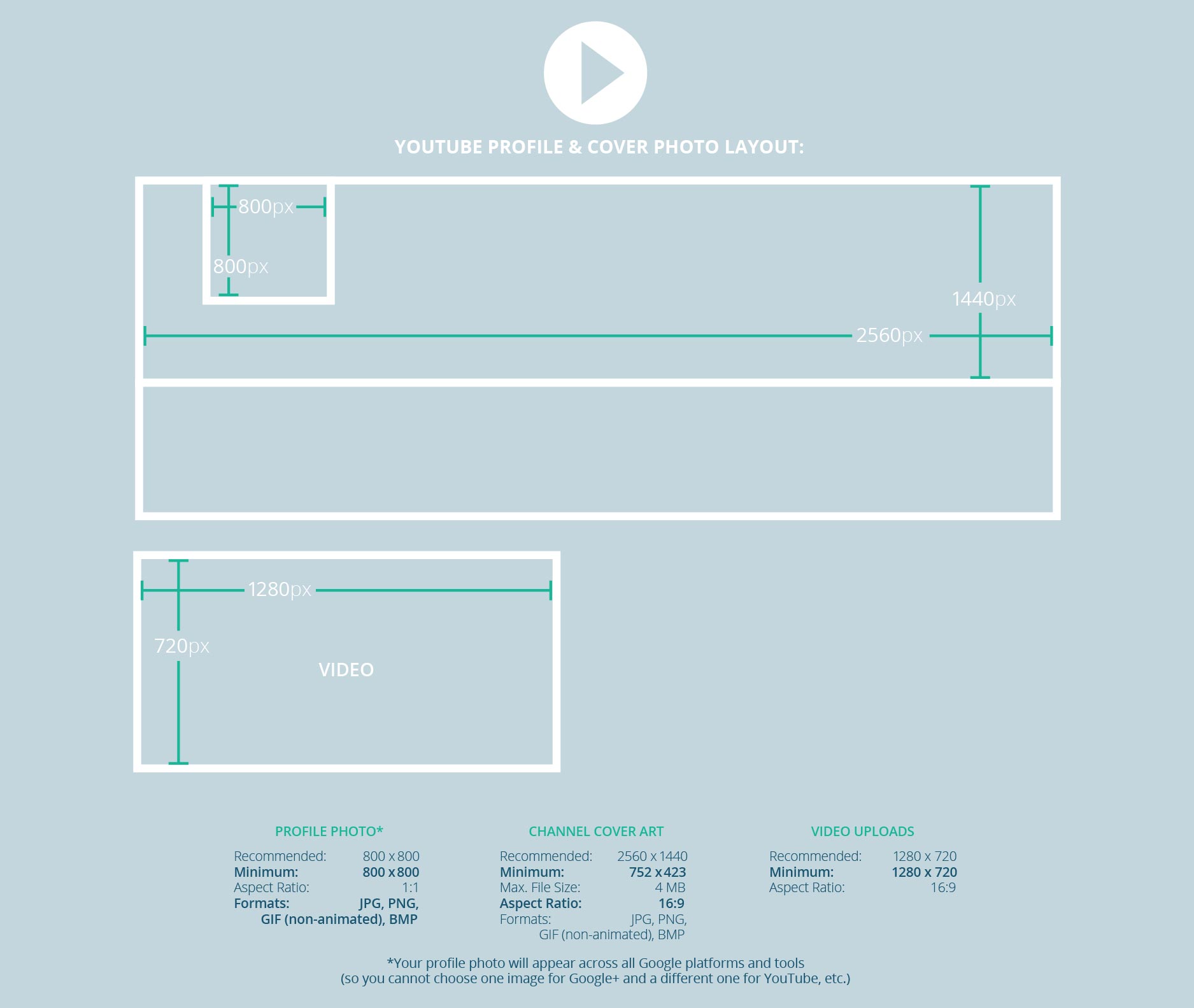
INFOGRAPHIC

Resource Credits:
For easy access to the information you’re looking for, click on one of the following to jump to that section:
Featuring high-quality imagery on Facebook shows your audience that your business is legitimate, reputable, and pays attention to the details (no matter how small).
Facebook wants to provide a positive user experience and prevent advertisers from being overly promotional or spammy, so they check to see how much text is featured in each image. Use this tool to see if your images adhere to Facebook’s text-to-image ratio.
PROFILE AND COVER PHOTOS
Most businesses use this space for their logo rather than a person’s photo. However, if your business is run by you and only you, using a photo of yourself might not be a bad idea.
SHARED IMAGE (TIMELINE & NEWS FEED)
These images appear both on your timeline and in most of your followers’ news feeds. With the decline of Facebook’s organic reach, try asking your fans to like or share your photos to gain visibility without a significant financial investment. Or consider paying a small fee to boost posts to ensure that your audience sees it in their feed.
SHARED LINK PHOTO
If you’re sharing a link to your business’ Facebook Page, there are a few more elements to consider and formats to choose from. When you paste a link into your status, depending on the size of the images on the web page, you’ll be prompted to include a carousel of up to 10 images. You also have the option of sharing the link without using the image — which can come in handy if you’d rather upload a new image to share with the link instead.
Pro Tip: Sharing images and links from other sources allows you to post relevant content to your page when you don’t have time to create your own. It’s also a great way to share content contributed by your audience or other businesses and keep promotions to a minimum.
Known for its real-time social buzz, Twitter is also an extremely popular customer service and experience tool for businesses.
PROFILE AND COVER PHOTO
Your profile photo will be visible on your profile, in your news feed, and next to a link in the “Who to follow” box. Most businesses use this as a place for their logo because it is seen practically everywhere: when you tweet, when others retweet your tweet, when their retweet gets retweeted, and so on.
Your cover photo, however, is only seen when a user clicks to your profile – but that doesn’t mean it’s not important! It’s a large photo across the top of your profile, so you want it to be high quality and represent your brand.
Note: Twitter recommends that you upload your cover photo dimensions at 1500 x 500 pixels, but because the cover photos are responsive, yours may look larger or smaller depending on the size of your browser or screen.
Pro Tip: Cover photos are a great place to describe what your brand does, display a new product, or use as free advertising space.
IN-FEED PHOTO
Twitter may have a limit of 140 characters, but you can use visuals to assist in representing your brand and sharing your content.
Attaching a photo to your tweet used to take away 23 characters (because it needed the URL to link to the photo), but in 2016, Twitter announcedthat links and media attachments (e.g. photos, GIFs, videos, and polls) will no longer count as part of the 140-character limit. This is great for marketers because tweets with images are over a third more likely to be retweeted than those with only text.

TWEETDECK
You can’t make separate images for Twitter and TweetDeck since TweetDeck is not a separate social network, so everything you post on one site will show up on the other (there’s no way around it).
However, you still want to take into consideration the way that your Twitter images appear on TweetDeck because the dimensions do vary in size a bit.
Pro Tip: Some of your header image design will be covered by your profile photo and bio in TweetDeck. So if you have important text or imagery that you’d prefer be seen at all times, be careful about centering those elements.
An example of a cover photo optimized for TweetDeck:

The same cover photo on the desktop version of Twitter:


Google+ underwent a substantial redesign in the last year, giving many marketers and everyday users hope for the social network’s future. When a user performs a Google search for your business, elements of your Google+ profile, such as your location and reviews, will likely be listed, as well as links to recent posts on Google+ (when applicable). So while Google+ may not be the top social media platform, it certainly shouldn’t be ignored.
PROFILE AND COVER PHOTO
Keeping in mind that your Google+ profile may show up in search results, you’ll want to ensure that your profile image is high quality and that you have recent posts available for viewing. Also note that even though you upload your profile photo as a square, it will display on your page as a circle.
Regarding your Google+ cover photo (as with most cover photos), it’s the largest image at the top of your profile, so you’ll want clear and creative visuals to portray your brand.
SHARED IMAGE
When sharing on Google+, you have the option to share publicly, within a Collection, in a Community, with a Circle, or with an individual. Collections are much like Pinterest boards where you can organize and collect images or links about a particular topic. It helps keep your content organized and allows other accounts to pick and choose which Collections they want to follow based on their areas of interest.
A Community is a place where people can discuss and share news on common topics of interest. Circles are your account’s followers grouped together based on certain criteria (e.g. friends, colleagues, etc.).
SHARED LINK
When you paste a link to share on Google+, it will pull a photo from the web page and add it to your link as a small square or rectangle, depending on the original image size. If the web page has multiple images on it, you can flip between them to choose the image you’d like to feature in your post.
Pro Tip: Sharing relevant content in Google+ Communities is a great way to raise brand awareness, promote your page, connect with other users, receive quality post engagement, and potentially get traffic to your blog/website.
But don’t overdo it: when you post to a Google+ Community it also shows up on your profile, so sharing the same post to several Communities tends to look spammy.
Note: Here is the old/”classic” Google+ profile layout, which you will see if you haven’t switched over to the new Google+ yet. Even if you have the new layout, you can switch back to the “Classic Layout” at your leisure.

Pinterest is also a great search tool, with 69% of users having purchased or considered purchasing something they found through a search on the network.
PROFILE PHOTO
This is one of the few platforms that doesn’t have a cover photo, so the representation of your brand rests heavily on the shoulders of your profile photo. Similar to Google+, Pinterest’s profile photo is uploaded as a square, but displays as a circle at the top of your profile.
PIN SIZE
With Pinterest’s layout being more portrait-oriented, vertically designed pins tend to perform better. When deciding on size, create a pin that caters to what you want to visually represent; larger pins do not necessarily mean you’ll attract more attention.
BOARD DISPLAY
The first thing you see when you visit someone’s Pinterest profile is their collection of boards. Name your boards appropriately and include a relevant cover photo for each of them. You don’t want empty boards (or no boards), but you don’t want a plethora of boards with no purpose, either.
Note: Some users began noticing a new Pinterest profile layout in July 2016 (see below). The new design has a larger profile photo next to the username and bio, along with a 3-photo grid for board cover photos.
Pro Tip: Ensure that your first two or three boards are directly related to your industry or audience. You don’t want visitors to leave your profile because they don’t understand what your business does or can’t quickly find the information they’re searching for.
Also, infographics tend to do really well on Pinterest.


LinkedIn is primarily for networking with other professionals, but it’s also a resource for businesses to connect with other businesses, prospective employees, and industry leaders. You can choose between a personal profile and business page (both with free or paid options).
PERSONAL PROFILE AND BACKGROUND PHOTO
You should have a respectable, professional photo of yourself for your personal LinkedIn profile.
On LinkedIn, the background photo replaces the “cover photo” at the top of your profile page. As an oblong shape, it can be difficult to find imagery that fits the space well – that’s where creating your own visuals comes in handy.
BUSINESS LOGO
The standard logo for a business account is a small square at the top of the profile page that is displayed next to your company’s name.
The square logo is what people see when they search for your company or see your posts in their news feed.
BUSINESS COVER AND BANNER PHOTO
Instead of a background, you can have a cover photo on a business page that stretches across your profile underneath your logo and company name.
Pro Tip: Use a photo of your employees or your business’ building as a banner photo – and avoid random stock photos. For background photos, it’s usually best to choose something subtle that doesn’t distract too much from the content of your profile.

Instagram is all about visuals, which should make the importance of high-quality images blatantly obvious for this social network.
PROFILE PHOTO
As with some other platforms, the profile photo is a circle that shows up next to all of your posts and at the top left of your profile page. For businesses, it’s a great idea to use your logo here so all of your photos are associated with your brand.
As of June 9, 2015, Instagram updated its profiles, feeds, and hashtag pages with a flat, minimal design – so there is no longer a cover photo.
Instagram also introduced the ability to upload portrait and landscape-oriented photos and videos in August 2015. And, to ensure images look sharp across all devices with high-resolution displays, Instagram rolled out support for images at a higher resolution (up to a 1080-pixel width) in July of 2015.
Pro Tip: This is a great place to show your company culture, what happens “behind the scenes” of your business, the process of creating your products, customers using your products, etc.

TUMBLR
Tumblr is a blogging and social platform where users share thoughts, quotes, music, articles, GIFs, videos, images – basically anything. Images are (of course) an important aspect of this social network, but text-based content is associated with Tumblr as well.
AVATAR (PROFILE PHOTO)
This photo will show up as a small square next to your posts in your followers’ main feeds and is embedded with your username in posts that users come across while perusing Tumblr.
You can choose a theme for your Tumblr page, which allows for added customization (think of it as a website or blog page); however, many users will still be able to see a “profile” preview with an avatar and header photo of your choice (see the GIF below for an example of the profile preview).

With that in mind, it’s important to remember that this header image will not show up on your Tumblr page unless you add it to your theme. Your avatar may also not be featured on your theme, but will show up as your Tumblr’s favicon on browser tabs.
Pro Tip: Consider placing your business’ logo directly on the photos you upload to increase brand visibility and recognition.

YOUTUBE
YouTube is a video-sharing social network that is accessed by users on the largest variety of devices, including tablets, phones, desktops, and televisions, so it’s important to have imagery that displays correctly across devices.
CHANNEL ICON AND CHANNEL ART
A small square profile photo overlays the top left corner of your YouTube page. As important as profile and cover photos are to representing your brand, on YouTube, many users will see one of your videos before them. This makes having striking images even more important so that users associate the videos with your brand and remember you when they do reach your profile page.
Note: Your YouTube account is connected to your Google+ account, so your channel icon will show up as whatever image you have as your Google+ profile photo. However, you can still upload a different image for the channel art.
Pro Tip: You only upload one image for your YouTube channel art, but it will display differently across different devices. When you upload an image, you can crop it to fit the desktop layout (see the GIF below for a demonstration) – but make sure the important elements are right in the center to ensure they aren’t cropped out on smaller screens.



INFOGRAPHIC

Resource Credits:


